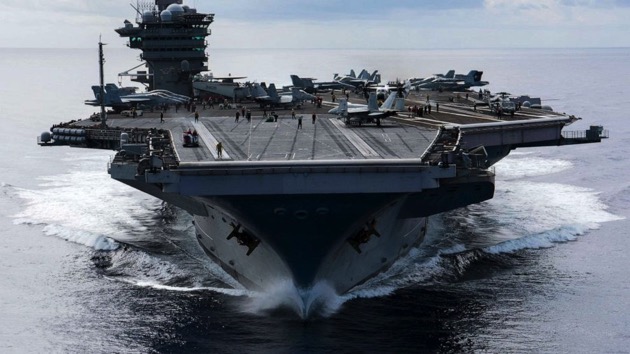
(NEW YORK) — The U.S. Navy has begun to make plans to recover the F-35C fighter jet that crashed Monday after striking the deck of an aircraft carrier in the South China Sea. The jet is the most advanced stealth fighter jet in the world and would have made an enticing target for China if it had attempted to recover it from the depths of the Pacific Ocean.
“The U.S. Navy is making recovery operations arrangements for the F-35C aircraft involved in the mishap aboard USS Carl Vinson (CVN 70) in the South China Sea Jan. 24,” said Brenda Way, a spokesperson for the Navy’s Pacific Fleet.
An earlier Navy statement had said that as the F-35 was attempting to land on the aircraft carrier Monday, “It impacted the flight deck and subsequently fell to the water during routine flight operations.”
Seven sailors, including the pilot who was able to eject safely, were injured in Monday’s crash according to the Navy.
The damage to the carrier’s deck was “superficial and all equipment for flight operations is operational,” which enabled the resumption of flight operations, said Lt. Mark Langford, a Seventh Fleet spokesman.
The crash of one of the most advanced fighter jets in the world into international waters had fueled speculation that the U.S. Navy might quickly launch a salvage operation to prevent other foreign powers, especially China, from trying to do the same.
“The race is on now to get the appropriate kind of recovery gear, the deep diving submersibles that actually pull the wreckage up off the bottom of the ocean,” said Steve Ganyard, a retired Marine aviator and ABC News contributor.
Ganyard believes China probably has a general idea of where the jet entered the waters of the South China Sea, making its advanced stealth technology an enticing target for China to launch its own salvage operation.
“The Chinese have it the U.S. Navy has it,” said Ganyard. “Both those countries are going to want to get a hold of this wreckage.”
It is unclear how deep the waters are where the F-35 fell into the Pacific, but the Navy has considerable experience in salvaging wreckage in deep waters. A salvage operation in 2019 in the Philippine Sea was able to recover a C-2A Greyhound aircraft that was three miles under the ocean.
While Monday’s crash marked the Navy’s first F-35C crash at sea, it will not be its first operation to salvage an F-35 aircraft.
Late last year, the U.S. Navy helped the British Royal Navy recover an F-35B fighter from the waters of the Mediterranean after it had crashed on takeoff from the aircraft carrier HMS Queen Elizabeth.
Monday’s crash occurred while the aircraft carrier USS Carl Vinson Strike Group was involved in a high-profile naval exercise with the aircraft carrier USS Abraham Lincoln Strike Group, the USS Essex Amphibious Ready Group, the USS America Amphibious Ready Group and a Japanese Maritime Self Defense helicopter carrier.
The participation of so many air capable and amphibious U.S. Navy ships operating together in the South China Sea highlights the U.S. Navy’s capabilities in a region where China continues to make maritime territorial claims.
Copyright © 2022, ABC Audio. All rights reserved.

